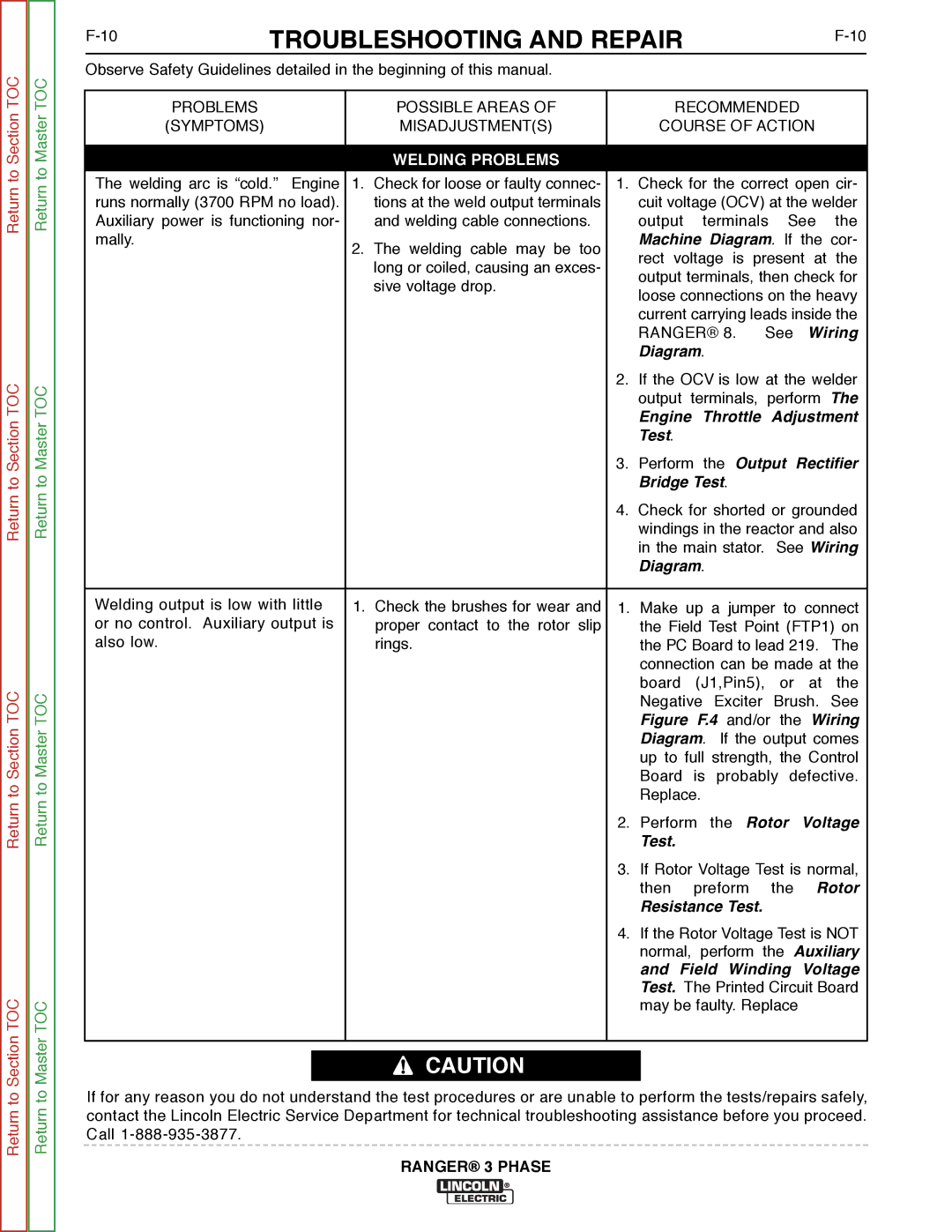
Return to Section TOC
Return to Section TOC
Return to Section TOC
Return to Section TOC
Return to Master TOC
Return to Master TOC
Return to Master TOC
Return to Master TOC
TROUBLESHOOTING AND REPAIR |
|
|
|
| |||||
|
|
|
|
|
|
|
| ||
|
|
|
|
|
|
| |||
Observe Safety Guidelines detailed in the beginning of this manual. |
|
|
|
|
|
| |||
|
|
|
|
|
|
| |||
| PROBLEMS |
| POSSIBLE AREAS OF | RECOMMENDED |
|
| |||
| (SYMPTOMS) |
| MISADJUSTMENT(S) | COURSE OF ACTION |
| ||||
|
|
|
|
|
|
|
|
|
|
|
|
| WELDING PROBLEMS |
|
|
|
|
|
|
The welding arc is “cold.” Engine | 1. | Check for loose or faulty connec- | 1. Check for the correct open cir- | ||||||
runs normally (3700 RPM no load). |
| tions at the weld output terminals | cuit voltage (OCV) at the welder | ||||||
Auxiliary power is functioning nor- |
| and welding cable connections. | output | terminals | See | the | |||
mally. |
| 2. | The welding cable may be too | Machine Diagram. If | the | cor- | |||
|
| rect voltage is present at | the | ||||||
|
|
| long or coiled, causing an exces- | ||||||
|
|
| output terminals, then check for | ||||||
|
|
| sive voltage drop. | ||||||
|
|
| loose connections on the heavy | ||||||
|
|
|
| ||||||
|
|
|
| current carrying leads inside the | |||||
|
|
|
| RANGER® 8. | See | Wiring | |||
|
|
|
| Diagram. |
|
|
|
| |
|
|
|
| 2. If the OCV is low at the welder | |||||
|
|
|
| output terminals, | perform | The | |||
|
|
|
| Engine | Throttle | Adjustment | |||
|
|
|
| Test. |
|
|
|
|
|
|
|
|
| 3. Perform the Output Rectifier | |||||
|
|
|
| Bridge Test. |
|
|
|
| |
|
|
|
| 4. Check for shorted or grounded | |||||
|
|
|
| windings in the reactor and also | |||||
|
|
|
| in the main stator. See Wiring | |||||
|
|
|
| Diagram. |
|
|
|
| |
|
|
|
| ||||||
Welding output is low with little | 1. | Check the brushes for wear and | 1. Make up a jumper to connect | ||||||
or no control. Auxiliary output is |
| proper contact to the rotor slip | the Field Test Point (FTP1) on | ||||||
also low. |
|
| rings. | the PC Board to lead 219. | The | ||||
|
|
|
| connection can be made at the | |||||
|
|
|
| board (J1,Pin5), or at the | |||||
|
|
|
| Negative Exciter | Brush. See | ||||
|
|
|
| Figure F.4 and/or the Wiring | |||||
|
|
|
| Diagram. If the output comes | |||||
|
|
|
| up to full strength, the Control | |||||
|
|
|
| Board | is probably | defective. | |||
|
|
|
| Replace. |
|
|
|
| |
|
|
|
| 2. Perform the Rotor Voltage | |||||
|
|
|
| Test. |
|
|
|
|
|
|
|
|
| 3. If Rotor Voltage Test is normal, | |||||
|
|
|
| then | preform | the | Rotor | ||
|
|
|
| Resistance Test. |
|
|
|
| |
|
|
|
| 4. If the Rotor Voltage Test is NOT | |||||
|
|
|
| normal, | perform | the | Auxiliary | ||
|
|
|
| and Field Winding | Voltage | ||||
|
|
|
| Test. The Printed Circuit Board | |||||
|
|
|
| may be faulty. Replace |
|
| |||
|
|
|
|
|
|
|
|
|
|
![]() CAUTION
CAUTION
If for any reason you do not understand the test procedures or are unable to perform the tests/repairs safely, contact the Lincoln Electric Service Department for technical troubleshooting assistance before you proceed. Call
